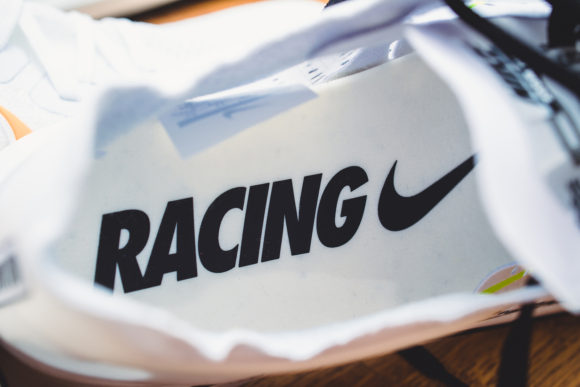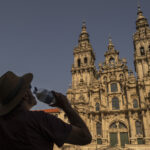The latest bombshell doping violation from track and field has also ensnared the sport’s biggest corporate backer: Nike Inc.
Legendary track coach Alberto Salazar, head of the famed Nike Oregon Project, was given a four-year ban from the sport this week for doping rules violations. The lengthy report that accompanied the ruling disclosed emails showing that Salazar and Jeffrey Brown, a Nike-paid physician who was also banned for four years, repeatedly informed Nike executives, including Chief Executive Officer Mark Parker, of what they were doing with drug tests.
The involvement from the highest management level casts a shadow over Nike’s vast efforts in track and field. The company does $4.5 billion in annual running sales alone, and its marketing within the professional ranks is a large part of that appeal. Nike is the biggest corporate backer of running both in the U.S. and abroad, with close partnerships with the U.S. Olympic committee and USA Track & Field, plus international events and national bodies.
“Running is Nike’s DNA,” said Rick Burton, a sports management professor at Syracuse University and former chief marketing officer for the U.S. Olympic committee. “This may cause people to wonder what Nike’s objective are, or why Nike is behaving this way. But I don’t think it will change Nike’s investment in track and field.”
It’s too early to tell what impact the sanctions may have on the corporation. The U.S. Anti-Doping Agency found that Salazar helped traffic testosterone, a banned substance, and tampered with evidence, but found no evidence that he administered the drugs to runners. Salazar has denied wrongdoing and says he will appeal. Nike said that it supports his decision to appeal, and that it does not condone doping.
Nike’s shares have dropped for three consecutive days amid declines in the stock market. Nike has fallen as much as 3.8% since Monday’s close, the biggest three-day decline in two months.
The accusations center around the Nike Oregon Project, the program that Salazar helped found in 2001. Based out of Nike’s Beaverton headquarters, he’s worked with some of the world’s top runners, helping win a handful of Olympic medals, but also drawn criticism over training techniques and allegations of doping.
Nike’s Swoosh
Nike’s swoosh looms large over the track world — larger than it does in most other sports. At the 2019 USA Track & Field Outdoor Championships, for example, 72% of the top-three finishers were Nike runners, according to data compiled by LetsRun.com. Among male athletes, it was 87%.
Salazar, a former champion himself who won three consecutive New York City marathons in the early 1980s, has been among the most important figures in preserving that status. He’s coached some of the top track athletes in the world, including Olympic medalists Mo Farah and Galen Rupp. The Oregon Project’s current runners include Dutch champion Sifan Hassan, who just won the women’s 10,000m at the World Championships in Doha, Qatar, and Donavan Brazier, who set a U.S. record in the men’s 800-meter.
As dominant as Nike may have been, the company is facing renewed pressure from rivals like New Balance and Puma, and smaller companies like Oiselle. In 2016, after an 800-meter runner named Boris Berian agreed to leave Nike for New Balance, Nike sued to keep him in its stable, a lawsuit that called attention to pressures many runners feel to sign with the sport’s biggest brands.
At the time, Nike’s annual marketing budget for track and field was between $60 million and $90 million, and higher in Olympic years, according to the Wall Street Journal.
Earlier this year, several current and former Nike track stars, including nine-time Olympic medalist Allyson Felix, spoke out against the company’s pregnancy policy, which they said unfairly punished female runners who decided to have children. In the aftermath, Felix chose to sign her next sponsorship deals with Gap Inc.’s Athleta brand. In another surprise news from a few months earlier, New Balance signed 20-year-old hurdler Sydney McLaughlin, considered by many to be the future face of U.S. track.
Yearslong Investigation
The USADA investigation into Salazar spanned over years, and while the arbitrators recommended punishment, they didn’t find any evidence that he gave banned substances to any Nike athletes. Instead, they concluded that experiments he conducted on his sons and a former Oregon Project coach, plus instructions he gave regarding the reporting of some treatments, were in violation of the rules.
In its 140-page report, the group of arbitrators says it does not believe Salazar had bad intentions when he broke the rules. In one 2009 email, Nike CEO Parker said he was interested in determining “the minimal amount of topical male hormone required to create a positive test.” Evidence from the arbitrators suggests that Salazar’s studies on how much hormone would trigger a positive test was done out of paranoia that someone else would try to sabotage Nike runners.
In a letter sent to employees Tuesday, Parker said that media reports that he was involved in a doping coverup weren’t accurate.
“To have my name and Nike’s name linked to this reckless characterization is offensive,” Parker said.
Nike didn’t respond to a requests for comment.
Salazar isn’t the first person connected to Nike to go through public doping allegation. The company famously stood by cyclist Lance Armstrong after USADA published a detailed report exposing his doping regimen (he was dropped by the company a week later). Armstrong’s name comes up a number of times in the Salazar report as well — at one point Salazar emails him with results from one of their tests. “You will finish the Iron Man in about 16 minutes less while taking this,” Salazar wrote, referring to long-distance triathlon races.
Standing Firm
“They’ve had a history in the past of standing firm when they believe an athlete or a representative of Nike is under challenge,” Burton said. “For example, Nike was one of the few brands that stayed with Tiger Woods through his entire process.”
Salazar was at the World Championships in Doha when the ruling came down and promptly had his credential revoked. The ban, however, doesn’t directly affect any Oregon Project athletes, who continue to compete at the event. Hassan, for example, will compete in the 1500-meter later this week.
That didn’t stop other athletes from speaking out, including U.S. steeplechase athlete Andy Bayer, who is a Nike athlete but not part of the Oregon Project team. After advancing to the finals in Doha, Bayer expressed anger over the revelations.
“I’m not that surprised, to be honest” Bayer said. “I don’t believe that every athlete in that group is dirty, but we need to get drug cheats out of the sport so I’m glad it came to the surface.”
Was this article valuable?
Here are more articles you may enjoy.


 More Resilient Organizations Successfully Battled Ransomware in 2024: BakerHostetler
More Resilient Organizations Successfully Battled Ransomware in 2024: BakerHostetler  Insurance Industry Contemplates Knock-On Effect of Tariffs to Claims, Consumers
Insurance Industry Contemplates Knock-On Effect of Tariffs to Claims, Consumers  Tariff Panic Spurs Fastest Retail Sales Growth in Two Years
Tariff Panic Spurs Fastest Retail Sales Growth in Two Years  Europe’s Hottest Year Turbocharged Extreme Weather Across Region
Europe’s Hottest Year Turbocharged Extreme Weather Across Region 